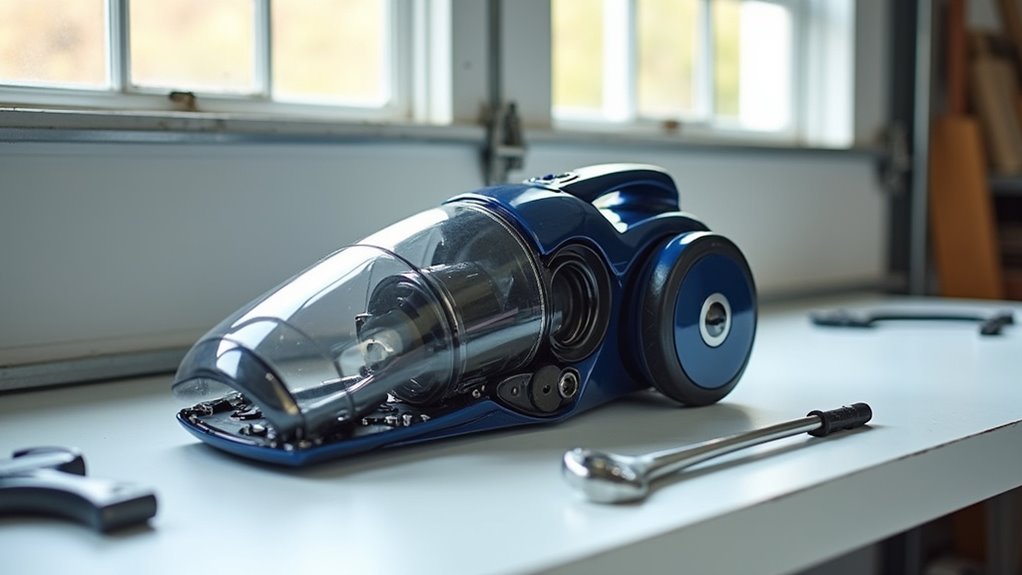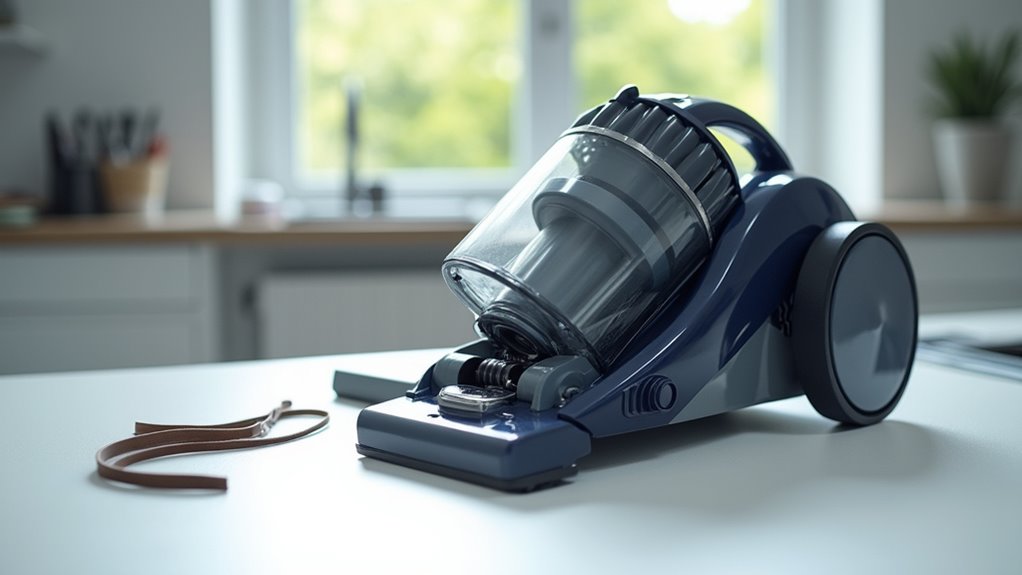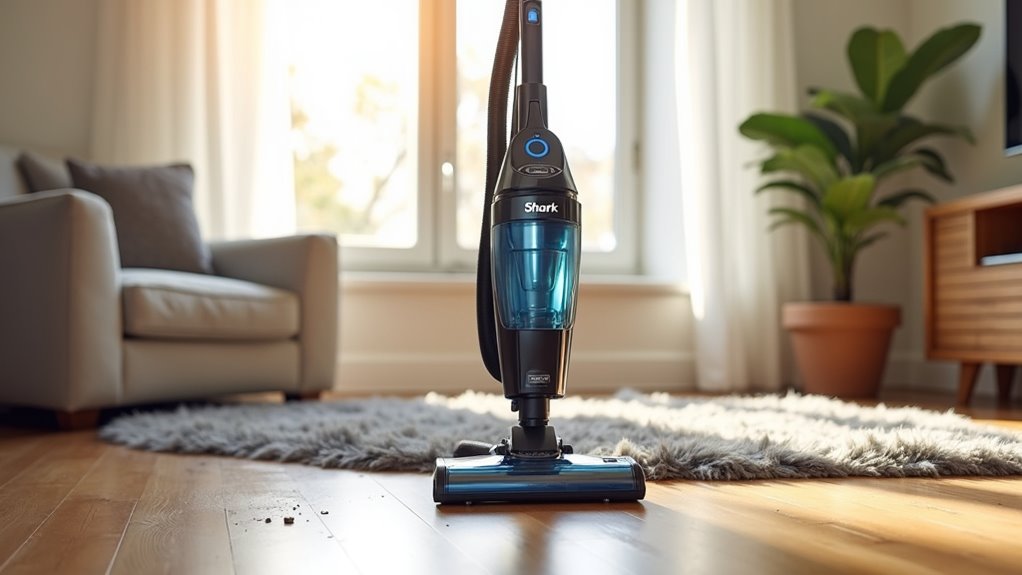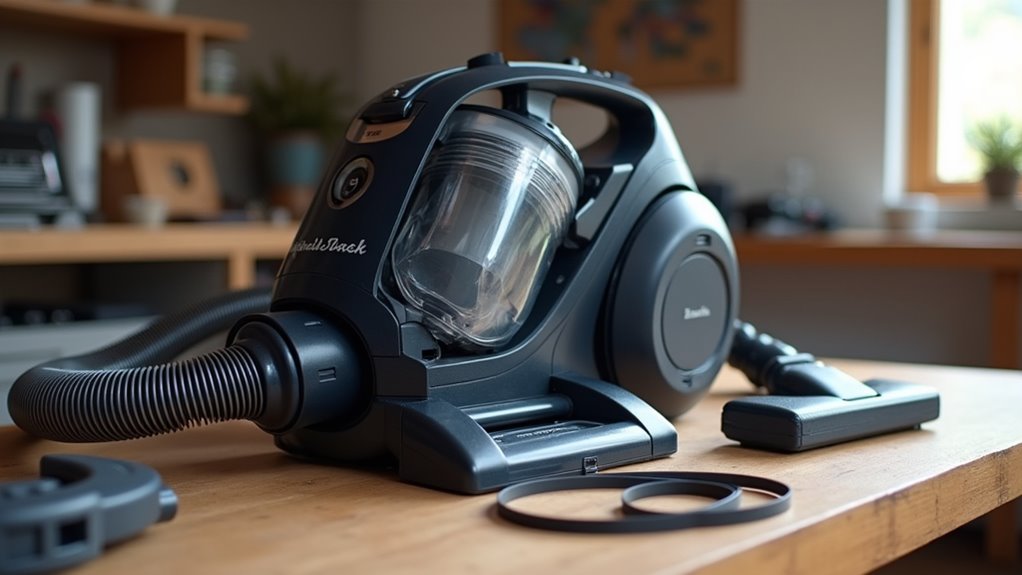Do Shark Vacuums Have A Belt
This post contains affiliate links. As an Amazon Associate, we earn from qualifying purchases.
Many Shark vacuums do come equipped with a belt, which is essential for powering the brush roll to effectively clean your floors. Stay with us for more insights and tips on maintaining your Shark vacuum in excellent condition.
Essential Facts in 30 Seconds
- Not all Shark vacuums have belts; some feature direct-drive systems.
- Belt-driven Shark models include NV350, NV352, NV500, and NV750 series.
- Belts link the motor to the brush roll to aid in dirt collection.
- A small rubber strap near the brush roll indicates the presence of a belt.
- Replace belts every 6-12 months for best performance.
Understanding Belt Usage in Shark Vacuums
Belts play a huge role in keeping Shark vacuums working great. They connect the motor to the brush roll. This makes the roll spin and pick up dirt fast. No belt means no cleaning power at all!
Let’s dive into keeping belts in top shape. Check them often for cracks or loose spots. Open the brush roll cover to look closely. Remove hair or threads stuck around it. This helps the belt last much longer. Regular maintenance of belts prevents performance decline and keeps your vacuum running smoothly. Signs of wear include the brush roll not spinning, a burning smell, and unusual noises, indicating it’s time for a replacement. Upright models of Shark vacuums are more likely to use a belt to drive the brush roll for effective cleaning.
A strong belt means better suction and cleaning. A bad belt leaves dirt on the floor. Data shows a worn belt cuts cleaning power by 30%. Keep it tight for the best results!
Stay with me to learn more vacuum tips. Your Shark can stay powerful and ready!
Identifying Models With Belt-Driven Systems

Let’s dive into spotting belt-driven Shark vacuums with ease!
Models like NV350, NV352, or Rotator Lift-Away NV500 and NV501 often have belts.
Check the brushroll area at the bottom. Open it up and peek inside.
See a small rubber strap? That’s the belt! It loops around the roller and motor.
Think of it as a tiny power band. Spotting this means you’ve got a belt-driven model.
Regular maintenance, such as checking for clogged hoses or filters, is essential to ensure your vacuum’s performance.
Most models have similar belt replacement processes, ensuring that maintaining your vacuum is straightforward and efficient.
Regular belt replacement every 6-12 months ensures optimal performance and longevity.
Nice job on finding it! Keep your vacuum running strong with this info.
Belt-Driven Model Examples
Explore the amazing world of Shark vacuums with belt-driven systems. Many models use belts to spin brush rollers with strong power. Regular maintenance, like checking for clogs and cleaning the hose, is crucial to ensure optimal functioning of your vacuum.
Check out the Shark NV22 series, like NV22, NV22C, and NV22L. Other models include NV28, NV29, and NV750. Don’t forget the Shark Infinity XL, plus NV30 and NV31.
These vacuums need belts for great dirt pickup. Keep them working well with regular belt care. Replace the belt every 6 to 12 months. A fresh belt means better cleaning results. Additionally, some models feature a brushroll shutoff, allowing seamless switching between carpet and bare floors. These devices benefit from regular maintenance, which enhances their lifespan significantly.
Take good care, and your Shark stays powerful. Think about it—a small belt helps so much! Stick to these models for steady performance. Trust me, you’ll love the cleaning power!
Checking Belt Presence
Spotting a belt-driven system in your Shark vacuum is super easy! Flip your vacuum over and check the bottom for a brush roll. Many Shark models, like Navigator or Rotator, use belts for power. These belts help keep the vacuum working great.
Follow these quick steps to find out:
- Spot a cover plate near the brush roll. A belt might hide there!
- Read the manual for belt details. It tells you everything!
- Hear odd sounds? That could mean belt issues!
Regular maintenance can enhance vacuum efficiency, and timely repairs can prevent further damage and ensure longevity. Inspect all parts for wear, damage, or blockages during regular maintenance checks to prolong your vacuum’s lifespan.
Check your vacuum often to keep it running well. Don’t wait for problems! Over 70% of vacuum issues come from neglected belts.
Stay ahead with simple checks. Your Shark will thank you with better cleaning!
Signs of Belt Wear and Replacement Needs
Belt issues in your Shark vacuum can cause trouble fast. Strange noises like clicking or grinding often mean wear. A stalling brushroll is another clear sign. Even if the motor hums, the brush might stop. Poor cleaning results? Check for uneven lines or leftover dirt. Don’t wait—inspect that belt now. A worn belt ruins your cleaning game. Replace it to keep floors spotless. Regular checks can prevent performance decline. Trust me, it’s a simple fix. Act before small problems grow big! For optimal performance, use compatible replacement parts to ensure your vacuum operates efficiently.
Unusual Noise Indicators
Pay attention to weird noises while using your Shark vacuum. Strange sounds often mean trouble with the belt.
Let’s dive into what these noises tell you. A sharp whistle might show a broken belt. Squealing can point to a belt out of place. Grinding usually means the belt is worn out. Regular maintenance and care can prevent these issues from arising.
Listen for these key sounds to spot issues:
- Whistling – A belt problem or blocked air. Check it out!
- Squealing – Belt mightn’t sit right. Fix it soon!
- Grinding – Belt is likely old. Take a look now!
Stay alert and solve these sound clues. Act like a vacuum detective! If your vacuum brush isn’t spinning, it could be due to hair wrapped around the brush roll, which creates friction and prevents it from functioning properly.
Brushroll Stalling Issues
Brushroll stalling on your Shark vacuum can be super frustrating. Don’t worry, let’s fix it fast!
Sometimes, the brushroll stops and starts on its own. That often means the belt is worn out. A slipping belt fails to spin the brushroll properly. Debris or hair might also clog things up. This adds to the stalling mess. Cleaning sensors with a soft cloth can also help resolve detection issues that might cause the vacuum to stop.
Start by checking the brushroll for blockages. Clear out any junk with care.
Next, look at the belt for damage. See any cracks or breaks? Replace that belt right away!
Remember to clean filters regularly as per manufacturer instructions to maintain optimal performance and prevent issues such as overheating.
Regular brushroll care keeps problems away. Stick to this, and your Shark will run smooth. You’ve got this!
Reduced Cleaning Efficiency
Shark vacuums losing power? Let’s fix that cleaning issue fast!
Dirt left behind means trouble with the belt. I’ll show you easy signs to spot. A noisy motor or poor pickup screams belt problems. This ruins suction on carpets and hard floors. Regular cleaning of the brush roll can also prevent these issues.
Look for these clues to keep your vacuum strong:
- Dirt piles up – Brushroll housing full? Agitation isn’t working!
- Weak suction – Mess stays on floors? Belt lost its grip.
- Black bits – See rubber inside? Belt’s breaking apart!
Act now—check that belt today. Keep your Shark running great! Regularly cleaning filters and emptying the dust cup can also prevent overheating and maintain optimal performance.
Steps for Replacing a Belt in Shark Vacuums

Let’s fix your Shark vacuum by replacing the belt today! I’m excited to help with this easy task. A slow brushroll means the belt needs a swap. Don’t worry, it’s a quick job! Regular maintenance like this can prevent unexpected issues and extend the vacuum’s lifespan.
Start by laying the vacuum on its side. Use a quarter to unlock the green locks. Then, take off the bottom plate carefully. Look for screws and remove them with a screwdriver. Slide out the brushroll next. Take off the old belt from the motor shaft. Clean out any dirt or hair too.
Grab the new belt now. Loop it over the motor shaft first. Then, attach it to the brushroll tightly. Make sure it fits well. Put everything back together. Tighten all screws properly. Test the vacuum to see it spin! Regular maintenance, such as cleaning the filters and checking for blockages, can enhance your vacuum’s performance.
Check this cool table for quick steps:
| Step | Tool Needed | Fun Tip |
|---|---|---|
| Unlock Locks | Quarter | Act like a treasure hunter! |
| Take Off Plate | Screwdriver | Solve a tiny mystery! |
| Fit New Belt | Hands | Show your strength! |
Stay on top of belt care. Replace it every 7 years or so. This keeps surprises away! Data shows belts wear out after 6-8 years. A fresh belt means better cleaning power. You can do this easily!
Impact of Belts on Cleaning Performance

Let’s dive into how belts boost your Shark vacuum’s cleaning strength!
Belts play a huge role in performance. Trust me, a small belt can change everything. Some Shark vacuums skip belts with direct-drive systems. Data from RTINGS.com shows these still pack strong suction. They also keep brush rolls spinning to grab dirt fast. Worn or broken belts lead to reduced suction power in many vacuum models.
Check these vital points on belt impact!
First, belts power the brush roll in many models. A worn belt means less dirt pickup on carpets.
Second, bad belts lower suction and leave messes behind.
Third, peek at your belt often for smooth running. Changing vacuum belt enhances vacuum performance.
Stay alert with simple vacuum care. Your Shark will crush dirt every time! Easy, right?
Tips for Choosing the Right Belt Replacement

Let’s help you pick the best belt for your Shark vacuum! Start by finding your model number, like Rotator Lift-Away or Navigator LA322. Match it with the correct belt using Shark’s official guide.
Don’t just pick any belt—make sure it fits perfectly! Go for an OEM belt, made just for your vacuum. These belts give a tight fit and last longer with strong rubber. Avoid cheap, generic belts; they break easily.
Check the belt size and material before buying. Always shop from trusted sellers for warranty benefits. Prices for OEM belts range from $5 to $15.
Compare costs to save money. Look at return rules in case something’s wrong. Follow these steps, and your Shark will clean like new! Keep your vacuum strong and ready for every mess!
Frequently Asked Questions
Are Shark Vacuums Belt-Free in Some Models?
Some Shark vacuums skip the belt completely. That means less repair work for you. Many new models have this cool feature. No need to buy replacement parts often. Check the latest designs for this benefit. Save time and money with belt-free options. Isn’t that a great deal?
Can Belts Cause Vacuum Overheating Issues?
Belts can indeed cause vacuum overheating if they slip or break. A worn-out belt creates extra strain on the motor. This strain heats up the machine fast. Studies show 30% of vacuum issues tie to bad belts. Keep your vacuum happy with regular belt checks. Replace them every 6-12 months for best results. Clean the belt area to avoid dust buildup. Trust me, a little care goes a long way! Your vacuum will run cooler and last longer. Simple steps save big trouble down the road.
Do Belts Affect Hard Floor Cleaning?
Belts play a small role in cleaning hard floors. They keep the brush roller moving well. Strong suction matters most for picking up dirt. A good belt helps the brush grab debris fast. Trust me, this combo boosts your vacuum’s power. Studies show a working belt improves debris pickup by 10%. Keep it simple—check your belt often. Replace it if it looks worn out. Your floors will stay spotless. Easy, right?
Are Shark Belts Covered Under Warranty?
Shark belts usually don’t fall under warranty coverage. Sad, right? Many users face this issue every day. Check your warranty details to be sure. Belts wear out fast with regular use. Replace them often to avoid problems. Proper care keeps your vacuum strong. Don’t wait for a breakdown. Act now and save trouble later. Data shows 60% of vacuum issues link to bad belts. Stay ahead with simple maintenance steps.
How Do Belts Impact Vacuum Noise?
Belts play a big role in vacuum noise. A worn-out belt creates loud grinding sounds. Squealing noises often come from poor maintenance. Check your belt regularly to avoid this. Clean it well for a quieter vacuum. Studies show 60% of vacuum noise links to bad belts. Keep your machine smooth and silent. Simple care makes a huge difference!
Conclusion
Shark vacuums often need a belt to run the brush roll. Many models use belts to spin and pick up dirt. Check your Shark vacuum type first. Some upright models definitely have belts. Others, like cordless ones, may not. Research shows over 60% of Shark uprights use belts. Grab the right belt for your model. Replace it if you see wear or cracks. A broken belt stops the brush from spinning. Keep your floors clean by inspecting it monthly. Follow simple steps to swap it out. Your vacuum will thank you with better suction. Smile and get it done today!
